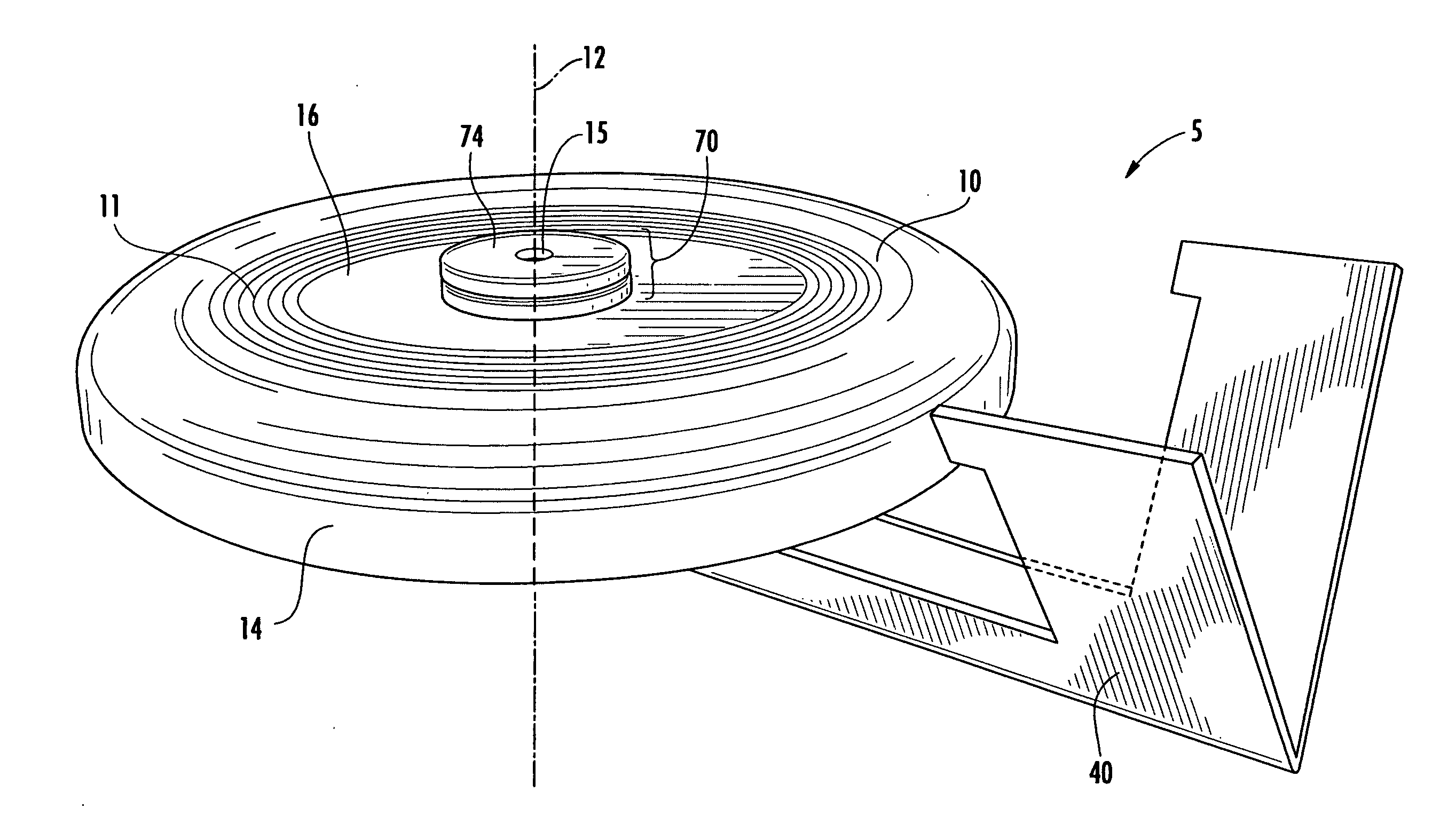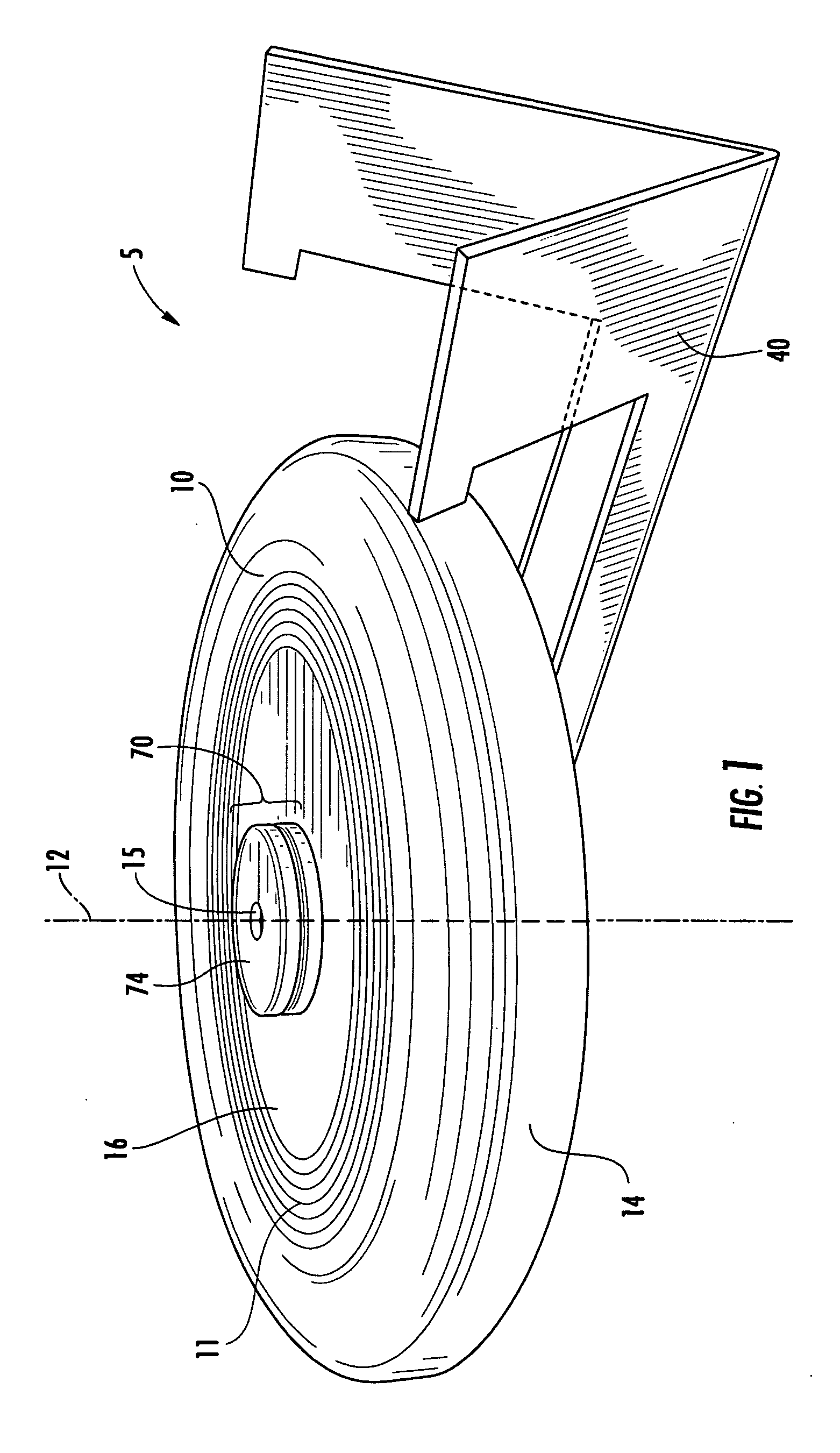Flying toy having gyroscopic and gliding components
a technology of gyroscopic and gliding parts, applied in the field of aerodynamic toys, can solve the problems of affecting the flight characteristics of the flying disc itself, many such devices have experienced stalling problems, and the stalling problem is usually present, so as to achieve the effect of improving the flight characteristics
- Summary
- Abstract
- Description
- Claims
- Application Information
AI Technical Summary
Benefits of technology
Problems solved by technology
Method used
Image
Examples
first embodiment
[0179]Structure of First Embodiment Apparatus
[0180]In various embodiments, as can be seen from FIGS. 1 and 2, the apparatus 5 includes a disc portion 10, a gliding body portion 20, and a rotating connection portion 70.
[0181]Generally described, the apparatus is assembled by positioning the disc portion relative to the gliding body portion as shown in FIG. 1, and completing the assembly of the rotating connection portion 70, which holds the two portions 10, 20, together.
[0182]Generally described, when the apparatus is thrown or otherwise launched in a general direction, the disc portion 10 is also given provided with spin or rotation about its central rotational axis (shown as 12 in FIG. 1), such that the gliding body portion 20“glides”, while the disc portion 10 rotates. The rotation connection portion has portions which glide, and portions which rotate, and provides a bearing connection between the two which preferably provides as little torsional drag between the two members 10, 2...
embodiment 105
Alternative Embodiment 105
[0266]FIG. 10A is a bottom view of an apparatus 105, which only includes a disc portion 110 and an aileron subassembly 160, but which does not include a fuselage subassembly. In this figure the gliding body portion 120, including the main body panel 130 and the aileron subassembly 160 (having a downwardly-directed arcuate aileron fin 164, is viewable.
[0267]A “positive pressure area”180 is shown outlined in dotted line in FIG. 10A. The airflow surrounding flying disc apparatuses has been mapped by various methods. In such maps, it has been found that the air pressure and the resulting force of that air pressure is highest in two locations relative to the disc portion 110. These locations are: (1) above and adjacent the leading edge of the disc portion 110 (i.e., toward the direction of flight), and (2) the rear of the cavity formed underneath the disc portion 110 (i.e., 180 degrees from the direction of flight). In order to have the maximum positive effect o...
embodiment 205
Alternative Embodiment 205
[0272]FIG. 11 is a bottom view of an additional embodiment apparatus 205, which includes an underside aileron subassembly 260 that is separate from the main body panel 230. The fuselage subassembly 240 is cut away for illustrative purposes. A pin 280 is also shown, which is for maintaining the angle of the aileron subassembly 260 with respect to the main body panel 230. The smaller isolated drawings shows the manner in which slots 290 in the underside aileron subassembly 260 fit around the downwardly-extending walls of the fuselage subassembly 240. The pin can fit through within the corrugated portion of the wall or be on the outside as desired.
PUM
 Login to View More
Login to View More Abstract
Description
Claims
Application Information
 Login to View More
Login to View More - R&D
- Intellectual Property
- Life Sciences
- Materials
- Tech Scout
- Unparalleled Data Quality
- Higher Quality Content
- 60% Fewer Hallucinations
Browse by: Latest US Patents, China's latest patents, Technical Efficacy Thesaurus, Application Domain, Technology Topic, Popular Technical Reports.
© 2025 PatSnap. All rights reserved.Legal|Privacy policy|Modern Slavery Act Transparency Statement|Sitemap|About US| Contact US: help@patsnap.com



